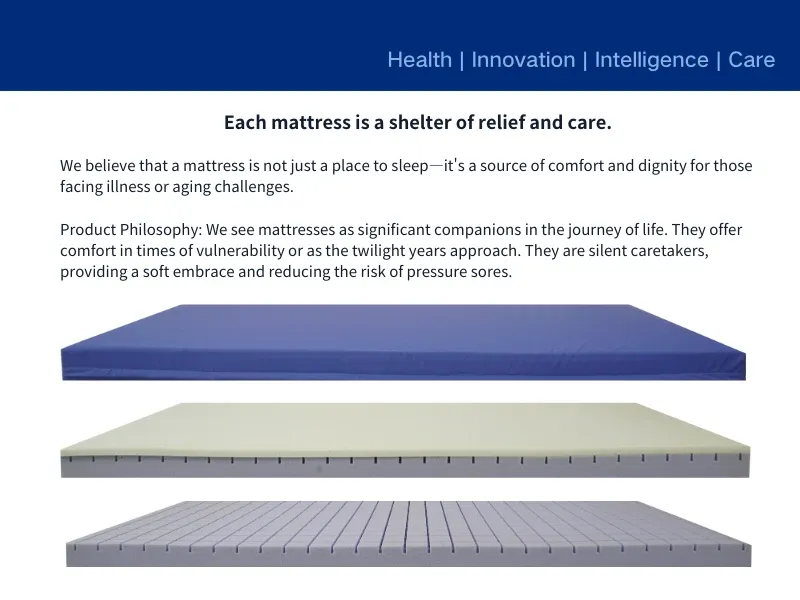Silicon Mattress and Its Role in Infection Control
In intensive care units where patients are highly vulnerable to infections, hygiene is not merely a preference—it is a necessity. The silicon mattress is engineered to meet the rigorous sanitation requirements demanded in such critical environments. Constructed from high-grade medical silicone, these mattresses offer a non-porous surface that prevents the accumulation of fluids, blood, and microbial contaminants.
Unlike traditional foam or spring mattresses that can harbor bacteria over time, the silicon mattress does not absorb moisture. This makes it remarkably easy to clean and disinfect, reducing the risk of cross-contamination between patients. In an ICU setting, where patients are often immunocompromised or undergoing invasive treatments, the hygienic properties of a silicon mattress play a pivotal role in promoting a safer healthcare environment.

Silicone Mattress and Pressure Injury Prevention
Another key benefit of the silicone mattress in the ICU is its ability to reduce pressure-related injuries. Immobile patients who spend prolonged periods in bed are at significant risk for pressure ulcers. The flexible and resilient nature of silicone allows for even weight distribution, alleviating stress on pressure points such as the heels, sacrum, and shoulders.
Moreover, the structure of the silicone mattress ensures it retains its shape and support characteristics even under long-term use. It adapts to the body’s contours, offering consistent pressure relief that minimizes skin breakdown. This feature not only contributes to patient comfort but also significantly lowers the workload of nursing staff, who must frequently reposition patients to prevent pressure injuries.
Silicone Gel Mattress and Advanced Patient Comfort
A step forward in ICU mattress technology is the introduction of the silicone gel mattress, which combines the hygienic benefits of silicone with enhanced ergonomic support. The gel infusion inside the mattress provides superior pressure redistribution and thermal regulation—two factors crucial for patients confined to bed for extended durations.
The silicone gel mattress is particularly effective in maintaining a stable temperature for patients who are feverish or undergoing post-operative recovery. Gel layers dissipate body heat more effectively than foam, preventing overheating and sweat accumulation. These features are essential in an ICU setting where patient comfort directly influences clinical outcomes.
Silicone Bed Mattress for Seamless Clinical Integration
A silicone bed mattress is more than a surface to lie on—it’s a medical tool designed to integrate with the technology and workflow of modern hospital beds. Whether the bed is motorized, articulating, or equipped with monitoring sensors, the silicone bed mattress conforms without losing its supportive properties. Its slip-resistant underside keeps it securely in place, ensuring patient stability during repositioning or transport.
The silicone bed mattress is also compatible with X-ray and MRI scanning protocols, allowing caregivers to conduct diagnostic imaging without moving the patient unnecessarily. This compatibility minimizes disruption to treatment schedules and reduces potential risks associated with frequent patient transfers—both critical factors in intensive care management.
Hospital Mattress Standards and the Silicone Upgrade
Standard hospital mattress models, while functional, often fall short in high-demand environments like ICUs. Over time, foam mattresses degrade, lose resilience, and may harbor odors or bacteria despite rigorous cleaning protocols. Replacing them frequently adds to hospital operational costs and risks patient dissatisfaction.
By contrast, a hospital mattress made of silicone delivers long-term performance, superior comfort, and consistently high hygiene standards. The upfront investment in silicone-based models is offset by fewer replacements, fewer pressure injuries, and improved patient recovery times. As healthcare facilities seek solutions that align with both financial and clinical goals, silicone mattresses have emerged as a preferred choice.
ICU Bed Mattress as a Critical Care Asset
The ICU bed mattress must meet more complex requirements than standard hospital bedding. It must support patients who are intubated, sedated, or undergoing constant medical intervention. The ICU bed mattress must also accommodate various positions—from flat for CPR to elevated for respiratory care—while maintaining its integrity and patient support.
The use of silicone in ICU bed mattresses enhances their capacity to respond to these demands. These mattresses are manufactured with modular zones or segmentations to allow independent adjustment and pressure relief in targeted areas. In addition, they are highly durable, resisting cuts, tears, and chemical damage from sanitizing agents.
ICU staff benefit from the ergonomic design of these mattresses, which reduces strain during patient handling and repositioning. And because the surface is smooth, waterproof, and resistant to staining, daily maintenance is simplified, improving workflow efficiency and allowing caregivers to focus more on direct patient care.
Investing in Silicone Mattress Technology for Better Patient Outcomes
The ICU nursing silicon mattress offers hospitals a comprehensive solution that prioritizes hygiene, safety, comfort, and sustainability. Whether it's the non-absorbent properties of a silicon mattress, the temperature control of a silicone gel mattress, or the integration compatibility of a silicone bed mattress, these products provide unmatched support in critical care settings.
As the expectations for hospital infrastructure continue to rise, especially post-pandemic, healthcare providers need to adopt solutions that not only meet clinical requirements but also improve operational efficiency. The hospital mattress has evolved from a simple bedding component to a critical tool for patient recovery—and the ICU bed mattress built with silicone technology is leading this evolution.
-
Sleep Tracking Mattress Maintenance TipsNewsJul.22,2025
-
Mattress Wave Designs for People with ArthritisNewsJul.22,2025
-
Mattress for Back Pain and Spinal AlignmentNewsJul.22,2025
-
Hypoallergenic Properties of Silicone Gel MattressNewsJul.22,2025
-
How a Gel Memory Foam Mattress Regulates TemperatureNewsJul.22,2025
-
Doctors’ Recommendations on Special Mattress for Back PainNewsJul.22,2025
-
Customizing a Patient Bed Mattress for Specific NeedsNewsJul.22,2025

